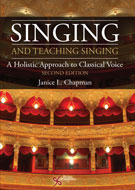Janice L Chapman
 Home
Home
 Read the foreword
Read the foreword
 Read reviews
Read reviews
 About Janice Chapman
About Janice Chapman
 Singing and Teaching Singing: A Holistic Approach to
Classical Voice Singing and Teaching Singing: A Holistic Approach to
Classical Voice
Janice L Chapman
Review of the Second Edition by Sue Anderson
Janice Chapman has taken the opportunity given by the need for a second edition of her highly successful book to make some additions and corrections. In particular, she has corrected misunderstandings that had arisen about using the Accent Method with classical singers. She emphasises that although 'vigorous movement of the tummy is used initially to ensure that the correct muscles are engaged in the correct order for supported airflow', later the movement should be both 'subtle and discreet'. John Rubin has added paragraphs describing research into the importance of the transversus abdominis muscle for controlled expiration. The invaluable exercise section in Appendix 1 now includes a description of the 'Puffy Cheeks' exercise and the 'Ultimate release for backed tongue'.
The new Appendix 3 is a transcription of the very thought-provoking lecture given by Janice at the Choice for Voice conference organised by the British Voice Association in July 2010, entitled 'Priorities in developing the young adult classical singer at music college'. She argues strongly that the conservatoire model that is suitable for instrumentalists is not suitable for singers for the simple reason that 'their instrument and their technique are largely underdeveloped'. She is clear that the first year in college should be concerned with the building of secure vocal technique, dependent on anatomical and kinaesthetic awareness and understanding, and allowing the instrument to mature safely without excessive extraneous demands. Listed as 'inappropriate or sometimes even counter-productive during the first year' are too much repertoire, vocal coaching that focuses on 'style and finesse', classes in languages other than Italian and English, and examinations. One sincerely hopes that these words of wisdom are heeded, for the future well-being of our professional singers.
Sue Anderson: (printed in Book Reviews "Singing – Voice of The Association of Teachers of Singing" No. 62, Summer 2012.)
Review of the First Edition by David Mason
As Janice Chapman states in the introduction to her new book,
Singing and Teaching Singing, A holistic approach to Classical
Voice, vocal pedagogy has changed significantly during the last 20
years as our scientific knowledge of the workings of the voice has
increased. She herself has been at the forefront of this
scientifically based , multidisciplinary approach to singing
teaching, having contributed to scientific research, and
collaborating with many important figures from the scientific and
medical world.
She describes her vocal pedagogy as Holistic; dealing with the whole
person (body, mind, spirit, emotion and voice); Physiological, based
on the laws of anatomy and muscular function; and Incremental,
meaning that singing can be broken down into manageable components,
thus enabling the development of a truly secure technique. There are
teachers who shy away from an overtly physiological approach,
believing that if the singer thinks too much about his diaphragm,
larynx, etc, then the pupil will be inhibited and physically blocked
rather than liberated. And it is true that to read about vocal
physiology in isolation is not necessarily very helpful. However
none of these reservations apply to the present work.
Apart from presenting some of the clearest explanations of vocal
physiology I have come across, every page is informed by years of
practical experience in the studio. The core components of her model
consist of the practice of the ‘Primal sound’ which is profoundly
connected to the breathing and support system, the latter being
dependent on good postural alignment. These three main core
components are clearly explained; in particular the controversial
subject of breathing and support is addressed in way which is both
scientific and practical. There is a further chapter later in the
book by ENT consultant John Rubin which explains vocal and
respiratory anatomy in greater depth, which should provide teachers
with concrete information to help them in their work.
Related to the core components of the model, and in a sense
dependent upon them for efficient functioning are such topics as
phonation, resonance, articulation. Again Chapman explains the
workings of the larynx in an impressively clear manner, explaining
attack, registers, etc.
The comprehensive nature of her vocal pedagogy is most impressive;
apart from the core components she tackles topics such as use of the
jaw, tongue in singing convincing Italian vowels, or articulating
consonants, how to achieve a ‘ringing’ tone. Despite her stated
advocacy of a scientifically informed vocal pedagogy, she does not
reject traditional ideas, indeed a number of her vocal exercises are
from old traditions of singing; however she explains how these ideas
actually work.
Apart from the contribution of John Rubin there are contributions by
other colleagues of Janice Chapman; of particular interest are those
by Pamela Davis, on the Voice and the Brain, and Adrian Fourcin, on
Hearing and Singing. This book cannot be too highly recommended, to
singers and singing teachers; the sheer wealth of scientific and
practical information is most impressive. Chapman herself states
that it is impossible to learn singing from a book; however with
this work she comes close to contradicting herself!
Reproduced with kind permission from The Singer magazine,
August/September edition 2006. To subscribe visit
www.rhinegold.co.uk

 Home
Home
 Read the foreword
Read the foreword
 Read reviews
Read reviews
 About Janice Chapman
About Janice Chapman
© Janice L Chapman 2013-2023
Descriptive text: courtesy of Plural Publishing Inc.
|